Today in History: November 28
The First American Automobile Race
At 8:55 a.m. on November 28, 1895, six "motocycles" left Chicago's Jackson Park for a 54 mile race to Evanston, Illinois and back through the snow. Number 5, piloted by inventor J. Frank Duryea, won the race in just over 10 hours at an average speed of about 7.3 miles per hour! The winner earned $2,000, the enthusiast who named the horseless vehicles "motocycles" won $500, and the Chicago Times-Herald, sponsor of the race, declared:
Persons who are inclined…to decry the development of the horseless carriage…will be forced…to recognize it as an admitted mechanical achievement, highly adapted to some of the most urgent needs of our civilization."The Future of the Motocycle", The Chicago Times-Herald, November 29, 1895.

Jackson Park, Chicago, Illinois, 1908.
Taking the Long View, 1851-1991
Only two years earlier in Springfield, Massachusetts, brothers Charles and J. Frank Duryea had built and driven what they claimed to be the first American gasoline-powered automobile. Yet, as if by spontaneous combustion, over 70 entries were filed for the Times-Herald race, a response so overwhelming that President Cleveland asked the War Department to oversee the event. Following their victory in the race, the Duryeas manufactured thirteen copies of the Chicago car, and J. Frank Duryea developed the "Stevens-Duryea," an expensive limousine, which remained in production into the 1920s.
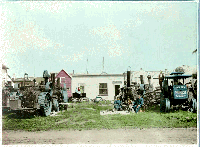
Samuel Holland's Repair Shop, The Only Automobile Manufacturing Plant in North Dakota at that Time, circa 1900.
The Great Northern Plains, 1880-1920
Samuel Holland, born in Norway in 1859, came to Park River, ND in the 1880s and established a blacksmith shop where he also spent time building self-propelled motor vehicles. In 1904, the local newspaper reported he had built an automobile, and may have built as many as eight. One copy of his automobile is known to exist.
There were American antecedents to the Duryeas' winning vehicle. As early as 1826, Samuel Morey filed a patent, bearing the signatures of John Quincy Adams and Henry Clay, for an internal combustion engine. George Brayton, Stephania Reese, Henry Nadig, and Wallis Harris all produced self-propelled machines.
Charles Black developed an 18 horsepower "chug buggy" in 1891—the same year John Lambert developed a three wheel motor buggy. After seeing the 1895 Times-Herald race, Lambert went on to produce four wheel vehicles at his Buckeye Manufacturing plant.
The Stanley twins built a steam-powered vehicle in 1897. The "Stanley Steamer" achieved fame when brother F. E. Stanley did a mile in 2:11 on a dirt track with a 30 degree incline.
George Eastman bought the rights to the Stanleys' earlier photographic patents, supplying the brothers with capital to manufacture 200 standing orders for the Steamer, which eventually became the "Locomobile." By the time Henry Ford incorporated the Ford Motor Company in 1903, the Stanleys' plant already employed 140 workers.
In the interview "Transportation," Arthur Botsford of Thomaston, Connecticut recalled his "first and fastest auto ride" and the earliest automobile makes:
I was hikin' along over towards Terryville to get the trolley and Jack come along and I flagged him. I was late. I says, "Jack, can we make the trolley?," and he says, "'Sure," and how we did fly. We made it all right.
The different cars they used to be. I used to keep a list of 'em. There was the Pope Hartford, and the Stevens Duryea, and the Locomobile, and the Peerless and the National, and the Saxon, and the Metz—I can't remember them all.
Billy Gilbert, that used to live next to me here, he had a Stanley Steamer. He was an engineer. He's out in Californy now. Spent all his life on the railroads and he swore by steam. Wouldn't have a gasoline engine.
After he moved to Californy he wrote me a letter. Said there was a big hill out there beyond San Francisco nine miles long. Said ten tow cars was kept busy on that hill all the time. But that steamer of his just ate it up."Transportation," Francis Denovan, interviewer, January 5, 1939.
American Life Histories, 1936-1940
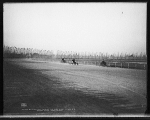
Riemer's Loco, Winning Five-Miles Event in 10:51 4-5, Grosse Pointe Track, Detroit, 1902.
Touring Turn-of-the-Century America, 1880-1920
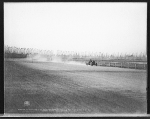
H.S. Harkness in his Mercedes-Simplex, Winning Five-Miles Event in 6:1 3-5, Grosse Pointe Track, Detroit, 1902.
Touring Turn-of-the-Century America, 1880-1920
Like its predecessor horse racing, automobile racing provided the stiff competition which helped to "refine the breed." When the Stanleys brought their 150 horsepower "T. E. (Thoroughly Educated) Wogglebug" to the 1906 winter races at Ormond Beach, Florida, driver Fred Marriott clocked 127.66 mph, becoming the first to move faster than 2 miles per minute.
In 1911 the Indianapolis 500 was born. This famous race fostered the development of innovations such as the rear view mirror. By the time Berna Eli "Barney" Oldfield sped to the top of Pike's Peak in 1915, motor car production was booming and automobile racing a well-established sport.
In a January 1926 issue of the American Automobile Association's magazine, The American Motorist, Walter Carver explained the influence of racing on innovations in motorcar construction:
Probably but few readers will associate this trend of reduction in engine size with the racing game, for to most people, racing is a game or a mighty dangerous sport which draws its actors from the sons of millionaires or "nut" garage hands…Racing is and has been more than a game. Men have given their lives to prove some point of better motor car operation…speed, acceleration, braking which must be attendant upon high speed, all have been bettered as the result of somebody's efforts at designing something better which went out and won on some perilous track.Walter Carver, "What the Show Will Show," The American Motorist, January, 1926.
Prosperity and Thrift: The Coolidge Era and the Consumer Economy, 1921-1929

Corona Speedway, Corona, California, 1913.
Taking the Long View, 1851-1991
- For a wide variety of related images, search the American Memory pictorial collections on the term automobile. Limit the search further by using the phrase automobile racing. Contrast the results of these searches with the result of a search on the term car. This search will yield a much wider variety of images including Pullman cars and dining cars, the "cook's car" on a Midwestern farm, motor car companies, armored cars, and more.
- Search the collection Prosperity and Thrift: The Coolidge Era and the Consumer Economy, 1921-1929 on automobile and car to find pertinent material about the early development of the automobile. The collection contains sample issues of the periodical The American Motorist for 1926. Don't miss these articles from the January 1926 issue:
- "What the Show Will Show" by Walter Carver, which discusses the latest automotive design and mentions the relationship of car racing to shifts in automotive design.
- "Peter the Great, King of Speed" by C. G. Sinsabaugh, a tribute to race-car driver Peter De Paolo.
- "Roaming Through Speed-Mad Years" by Fred J. Wagner, the reminiscences of "the official starter of practically every important automobile race for the last twenty years."
- The American Life Histories, 1936-1940 interview with Roy A. Morse provides a little farming folklore followed by an account of early automobile ownership. Search the collection on automobile to find more stories.
- Search the collection Historic American Sheet Music, 1850-1920 (Duke University) on automobile to find early motoring songs such as "In My Merry Oldsmobile" (1905) by Gus Edwards and "He'd Have to Get Under Get Out and Get Under (To Fix Up His Automobile)" (1913) by Maurice Abrahams.
- See a film of New York City's first annual automobile parade, held on November 4, 1899. Search on the term automobile in The Life of a City: Early Motion Pictures of New York, 1898-1906.
- Search on the terms automobile and racing automobile in History of the American West, 1860-1920 to view images such as Pike's Peak, Early Hill Climb, and Auto Race.
Crossing the Pacific
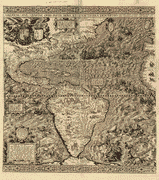
First Map of California, by Diego Gutierrez, 1562.
1492: An Ongoing Voyage
Having sailed from the Atlantic Ocean through the passage that came to be known as the Straits of Magellan, three ships under the command of native Portuguese explorer Ferdinand Magellan entered "The Sea of the South" on November 28, 1520. Thus the first westward crossing of the Pacific Ocean was launched.
The fleet reached the island of Guam on March 6, 1521 after a voyage so remarkable for its calm that the explorers called the ocean "Pacific." Setting foot on land, the crew that had been reduced to eating leather enjoyed fresh food for the first time in 99 days.
Magellan was killed on April 27, 1521 in fighting with natives of Mactan Island in the Philippines. The following September, one of the fleet's five ships returned to Spain laden with spices, thereby completing the first circumnavigation of the globe and vindicating Magellan's vision of an alternate route to the Spice Islands.
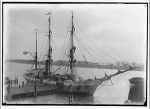
Admiral Byrd's Ship, City of New York (After South Pole Trip), Washington, D.C., Theodor Horydczak, photographer, circa 1920-1950.
Washington as It Was, 1923-1959
- Search the Today in History Archive on explorer to find other features, such as those on Jacques Cartier, Ponce de Leon and the pages of August 3rd and October 12th on Christopher Columbus.
- Search the American Memory collections on explorer to find more material on exploration.
- Washington as It Was, 1923-1959 has several photographs of a ship used by Admiral Richard E. Byrd on one of his four expeditions to the South Pole; to locate these, search the collection on Byrd.
- Visit the Library of Congress online exhibition examining the impact of European exploration of the Americas, 1492: On Ongoing Voyage.